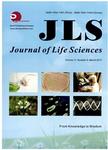EAE (Experimental Autoimmune Encephalomyelitis), Corticotropin-Releasing Factor and the Blood Brain Barrier
EAE (Experimental Autoimmune Encephalomyelitis), Corticotropin-Releasing Factor and the Blood Brain Barrier作者机构:Biological Sciences Kent State University Kent Ohio 44242 USA
出 版 物:《Journal of Life Sciences》 (生命科学(英文版))
年 卷 期:2014年第8卷第4期
页 面:295-305页
学科分类:0710[理学-生物学] 07[理学] 08[工学] 080401[工学-精密仪器及机械] 0804[工学-仪器科学与技术] 0803[工学-光学工程] 071003[理学-生理学]
主 题:EAE (experimental autoimmune encephalomyelitis) corticotropin-releasing factor blood brain barrier astrocytes.
摘 要:EAE (experimental autoimmune encephalomyelitis) is an established, inducible animal model employed in the study of MS (multiple sclerosis) characterized by inflammation, BBB (blood brain barrier) malfunction, demyelination and neuronal disruption. CRF (corticotropin releasing factor) is a neuropeptide critically associated with immune function, BBB permeability, and the hypothalamic-pituitary-adrenal axis. Potential CRF targets in the brain include astrocytes, as well as endothelial cells of cerebral microvessels, since they have been reported to express CRFR (CRF receptors). Further, both of these cell types function critically in regulating BBB permeability. CRF-BP (CRF binding protein) is also expressed in both neurons and glial cells. Changes in the cortical CRF system could be a contributing factor to the BBB disruption associated with MS/EAE and has been suggested to play a protective role against cytokine-induced inflammation. The current study assessed alterations associated with the C57BL/6 mouse model of EAE in the cortical CRF system and correlated these events with changes to the microvascular unit. Immunohistochemical confocal microscopy was used to analyze the distribution of CRF, CRF-BP, and CRFR in the mouse cerebral cortex. The authors observed a reduction in detectable CRF immunofluorescence in the EAE motor cortex, an increase in CRFBP immunoreactivity in EAE astrocytes and a concurrent reduction in astrocytic CRFR immunofluorescence. Staining techniques were used to visualize astrocytes/microvessels to document alterations in BBB integrity. Changes in the CRF system were associated with a modification of the blood brain barrier as manifested by a poorly defined astrocytic barrier in EAE microvessels. Evidence suggests that manipulation of CRF signaling pathways offers an intriguing target for interventional therapies designed to modify BBB permeability that may be beneficial for treating disease states such as MS.



